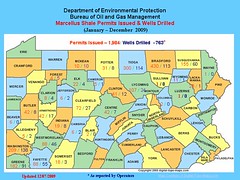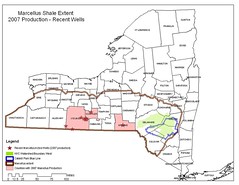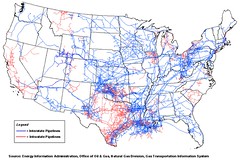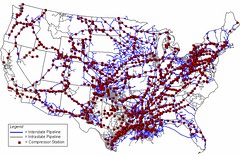West Virginia Highlands Voice
The blog of the West Virginia Highlands Conservancy
Beyond all the other environmental issues involved with horizontal gas wells on Marcellus Shale, such as water pollution from fracking and air pollution from heavy truck traffic, remain the serious air quality issues related to compressor stations and flaring.
This may help explain reports of gas odors from the area around New Milton, west of Clarksburg. Natural gas (methane) is odorless, but odor is added to serve as a warning in case of leaks.
(Most of this information is from http://www.marcellus-shale.us)
Compressor Stations
Once gas wells are producing, next come the gas lines, and compressor stations to move the gas. Whether it’s the adverse effects of one compressor station, or the cumulative effects of many, the town of Dish, Texas has become the poster child for these air quality issues.
One university expert, Al Armendariz, whose study was backed by Texas state officials, has indicated that air pollution created by Barnett Shale gas drilling and production in Texas is equivalent to all the air pollution created by vehicular traffic in Texas. Similar reports out of Colorado have shown a link between gas production activities and haze.
The air quality issue in Dish became severe enough that the town commissioned a thorough study of local air quality. You may listen to NPR story on air quality and noise issues in Dish, Texas:
Methane Leaks
There is also the possiblity of methane leaks. Below is a photo showing such a link. To see a video of a compression station in Texas, to http://www.youtube.com/watch?v=tDMeDhxqkbI First you see what looks like clear blue sky taken with regular camera; then you see what was taken with FLIR camera:
Flaring a Gas Well
After a Marcellus gas well is drilled and hydraulically fractured, open flaring is often used to test production of the well. The EPA and WV DEP do not currently monitor or enforce any air quality regulations around Marcellus Shale natural gas wells and facilities, since drillers are exempt from the Clean Air Act. Important environmental oversight was removed by Congress in the 2005 Federal Energy Appropriations Bill, which also includes additional exemptions from the Clean Water Act, Safe Drinking Water Act and CERCLA.

To the naked eye, no emissions from an oil storage tank are visible. But viewed with an infrared lens, escaping methane is evident.
Photographs by the U.S. Environmental Protection Agency
A large number of pollutants are released into the air during the flaring process, making it an undesirable practice. Included in these airborne pollutants are the chemicals used to frac the well, as well as any of 5-dozen other pollutants including the following: acetalhyde, acrolein, benzene, ethyl benzene, formaldehyde, hexane, naphthalene, propylene, toluene, and xylenes.
***This video, from Rancho Los Malulos, offers an ongoing view...
THE BETTER WAY
Drilling companies could use “green completions” to improve air quality and provide themselves with extra revenue. These are mentioned in a January 2009 report by Dr. Armendariz of Southern Methodist University:
“Green Completions” or”The Green Flowback Process”
“Some recent reports of the effectiveness of green completions in the U.S. are available, including one by the U.S. EPA which estimated 70% capture of formerly released gases with green completions. If green completion procedures can capture 61% to 98% of the gases formerly released during well completions, the process would be a more environmentally friendly alternative to flaring of the gases, since flaring destroys a valuable commodity and prevents its beneficial use. Green completions would also certainly be more beneficial than venting of the gases, since this can release very large quantities of methane and VOCs to the atmosphere. Another factor in favor of capturing instead of flaring is that flaring can produce carbon dioxide (a greenhouse gas), carbon monoxide, polycyclic aromatic hydrocarbons, and particulate matter (soot) emissions.”
DEMAND ACCOUNTABILITY!



















No comments:
Post a Comment